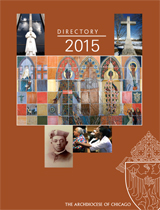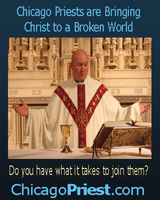Election offers a chance for understanding U.S. bishops’ conference very active in church but little known by Catholics
If Chicago Catholics notice Cardinal George’s appearance increasing in the local and national news in the coming months, most likely it’s because he is now president of the U.S. Conference of Catholic Bishops.
It’s quite possible many area Catholics have never heard of the U.S. Conference of Catholic Bishops (USCCB). So what is it? The Catholic New World pulled together the following information to provide a brief overview of the USCCB and its relationship to Catholic life in this country.
What is the USCCB and how long has it existed?
Today’s USCCB began back in 1917 as the National Catholic War Council when American bishops wanted to help dioceses work together in ministry to our military fighting World War I.
Two years later, Pope Benedict XV asked the bishops of the world to work for peace and social justice to prevent another war. So, the name changed to the National Catholic Welfare Council, its mission evolved and a headquarters opened in Washington, D.C., where it remains today.
Once again, the name and mission evolved. In 1922, the council changed to a conference and the group addressed such concerns as education, immigration and social action.
This model continued until 1966 when the National Conference of Catholic Bishops (NCCB) and the U.S. Catholic Conference (USCC) were established.
The NCCB attended to the church’s own affairs in this country, fulfilling the Second Vatican Council’s mandate that bishops “jointly exercise their pastoral office.” The NCCB operated through committees made up exclusively of bishops, many of which had full-time staff organized in secretariats.
In the USCC, the bishops collaborated with other Catholics to address issues that concerned the church as part of society. Its committees included laypeople, clergy and religious in addition to the bishops.
In 2001, the NCCB and the USCC combined to form what exists today — the U.S. Conference of Catholic Bishops. It continues all of the work done by the previous two groups. The bishops meet twice a year to address issues within the church here.
It can seem like there are too many layers of bureaucracy in the church? Why do we need the USCCB?
We don’t necessarily, but it can help, as Cardinal George wrote in his column (CNW Nov. 11-24): “In order to direct and shepherd effectively, pastoral institutions were gradually created: parishes, where Christians could be pastored by priests; and synods or councils, where bishops could come together to decide jointly on pastoral practices.
“Neither parishes nor bishops’ conferences are of divine origin. The Church could exist without them, but both have proven pastorally useful.”
Who is a member?
All of our country’s bishops and those in the Virgin Islands. Other countries have bishops’ conferences as well.
How does the work of the USCCB impact the Catholic in the pew?
It’s more of a trickle-down effect than a direct impact. The conference does a lot of lobbying of officials on issues that usually relate to upholding the human dignity of each person (i.e., just wages, immigration) and protecting the sanctity of life at all stages (i.e., euthanasia and abortion).
Staff also develops publications on topics about which the bishops want to enhance Catholic understanding. Dioceses and parishes can then share these materials with the faithful.
For example, for the past 30 years, the U.S. bishops have published “Faithful Citizenship” around the time of presidential elections. This booklet gives an overview of the Catholic understanding on issues important to voters.
How has the conference responded to the clergy sex-abuse crisis?
The conference enacted the Charter for the Protection of Children and Young People, which are the policies to prevent abuse of children by clergy, religious and laypeople in the church adopted by U.S. dioceses.
As part of the charter, the Office of Child and Youth Protection was created and helps dioceses implement and comply with the charter and conducts annual reviews of dioceses and their charter compliance.
The bishops also commissioned a report by the John Jay College of Criminal Justice- The City University of New York — presently underway — to study the causes and context of abuse on both the individual and on a larger, organizational level.
Does Cardinal George now preside over all U.S. bishops as president?
No. As the cardinal wrote in the last issue (Nov. 11-24), “There is no pastor of the United States, no bishop of the whole country. There is only a president of the conference, elected with the other officers for a term of three years to carry out the policies decided upon by the bishops of the conference.”
However, we will see him in the news more as conference spokesman, and he continues as archbishop of Chicago.

CNS/Nancy Wiechec
U.S. bishops online
At www.usccb.org, Catholics can:
- Check out reviews and ratings of
latest movies - Get readings for daily and Sunday
Masses or listen to a podcast of the
readings - Subscribe to a PDA version of Mass
readings and reflections - Read latest Catholic news
- Search inside the New American
Bible and the Catechism of the
Catholic Church - Find the name of any bishop in any
state - Locate contact information for U.S.
dioceses - Read Vatican documents and the
latest conference statements - Order books and resources such as
“Catholic Household Blessings and
Prayers”
 Catholic
New World - Newspaper for the Archdiocese of Chicago
Catholic
New World - Newspaper for the Archdiocese of Chicago Archdiocese of Chicago Directory
Archdiocese of Chicago Directory Oficjalne wydawnictwo Archidiecezji Chicago w języku polskim
Oficjalne wydawnictwo Archidiecezji Chicago w języku polskim